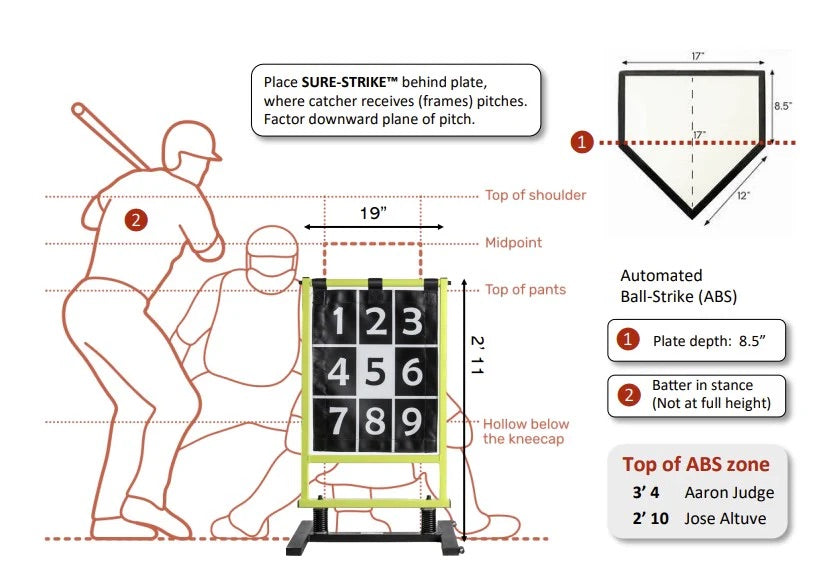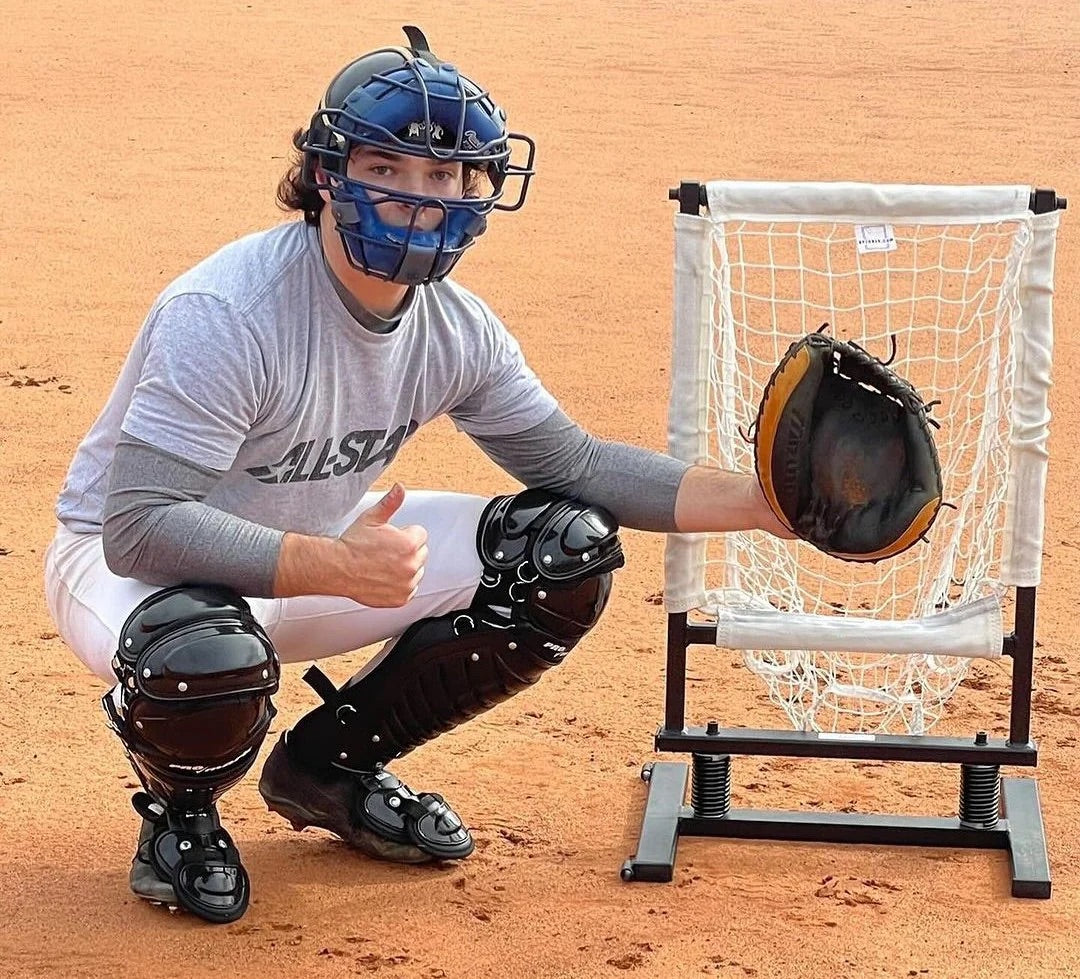
“The official strike zone is the area over home plate from the midpoint between a batter’s shoulders and the top of the uniform pants — when the batter is in his stance and prepared to swing at a pitched ball — and a point just below the kneecap. In order to get a strike call, part of the ball must cross over part of home plate while in the aforementioned area.
Strikes and balls are called by the home-plate umpire after every pitch has passed the batter, unless the batter makes contact with the baseball (in which case the pitch is automatically a strike).
History of the rule: The vertical specifications of the strike zone have been altered several times during the history of baseball, with the current version being implemented in 1996.”
“The official strike zone is the area over home plate from the midpoint between a batter’s shoulders and the top of the uniform pants — when the batter is in his stance and prepared to swing at a pitched ball — and a point just below the kneecap. In order to get a strike call, part of the ball must cross over part of home plate while in the aforementioned area.
Strikes and balls are called by the home-plate umpire after every pitch has passed the batter, unless the batter makes contact with the baseball (in which case the pitch is automatically a strike).
History of the rule: The vertical specifications of the strike zone have been altered several times during the history of baseball, with the current version being implemented in 1996.”
Yes. Move it further back from home plate to adjust for tall batters. Factor in the downward plane of the pitch. Place the BP Strike Zone where a catcher receives (frames) the pitch.
TOP OF THE STRIKE ZONE
Automated Ball-Strike (ABS) Challenge System
https://www.mlb.com/news/abs-system-pitch-timer-bigger-bases-tested-triple-a
José Altuve: 2’10”
Aaron Judge: 3’4”
BP Strike Zone: 2’11”
IMPORTANT NOTE: The ABS strike zone heights for Altuve and Judge are measured:
- At a home plate depth of 8.5 inches (halfway across the plate). This home plate depth is “the area over home plate’” where strikes and balls are called “after every pitch has passed the batter.” (see MLB strike zone definition FAQ above).
- Where “the batter is in his stance and prepared to swing at a pitched ball.” Rather than at the full height of each batter. (see MLB strike zone definition FAQ above).
We recommend placing the BP Strike Zone about 1 foot behind home plate, where catchers receive the pitch. Known in-game strike zone variables: pitch velocity (slower pitch = steeper downward plane), curveball vs fastball, level of play (Little League, high school, college, MLB), presentation by catcher, judgment of home plate umpire.
Yes. Move it further back from home plate to adjust for tall batters. Factor in the downward plane of the pitch. Place the BP Strike Zone where a catcher receives (frames) the pitch.
TOP OF THE STRIKE ZONE
Automated Ball-Strike (ABS) Challenge System
https://www.mlb.com/news/abs-system-pitch-timer-bigger-bases-tested-triple-a
José Altuve: 2’10”
Aaron Judge: 3’4”
BP Strike Zone: 2’11”
IMPORTANT NOTE: The ABS strike zone heights for Altuve and Judge are measured:
- At a home plate depth of 8.5 inches (halfway across the plate). This home plate depth is “the area over home plate’” where strikes and balls are called “after every pitch has passed the batter.” (see MLB strike zone definition FAQ above).
- Where “the batter is in his stance and prepared to swing at a pitched ball.” Rather than at the full height of each batter. (see MLB strike zone definition FAQ above).
We recommend placing the BP Strike Zone about 1 foot behind home plate, where catchers receive the pitch. Known in-game strike zone variables: pitch velocity (slower pitch = steeper downward plane), curveball vs fastball, level of play (Little League, high school, college, MLB), presentation by catcher, judgment of home plate umpire.
No. We stood on mounds 46, 50, 54, and 60 feet away from the BP Strike Zone. We asked ourselves (along with players, coaches, and umpires): Is this a fair strike zone for the majority of batters? YES. Should we add the option (and increased costs, small parts, compromised frame durability) to raise the height by a few inches? NO. We do weld (fixed) custom frames to specified heights.
No. We stood on mounds 46, 50, 54, and 60 feet away from the BP Strike Zone. We asked ourselves (along with players, coaches, and umpires): Is this a fair strike zone for the majority of batters? YES. Should we add the option (and increased costs, small parts, compromised frame durability) to raise the height by a few inches? NO. We do weld (fixed) custom frames to specified heights.

ABS Zone
Place Sure-Strike™ behind plate,where catcher receives (frames) pitches.
Factor downward plane of pitch.
1-page instruction manual. Click heret o see a brief video. Use the Allen wrench and 4 socket cap bolts to fasten the 2 extension springs, upper frame, and base frame. Takes about 5 minutes.
1-page instruction manual. Click heret o see a brief video. Use the Allen wrench and 4 socket cap bolts to fasten the 2 extension springs, upper frame, and base frame. Takes about 5 minutes.
1” square tube steel.Heavy-duty.
1” square tube steel.Heavy-duty.
31 lbs with standard base frame.
38 lbs with Super base frame.
31 lbs with standard base frame.
38 lbs with Super base frame.
It’s a ball, not a strike.(You’d be surprised how often we are asked this question)
It’s a ball, not a strike.(You’d be surprised how often we are asked this question)
Easy transport from your home or car to the baseball field or batting cages.These 7” wheels are quickly removed and attached (detent pins, steel sleeves welded to base).Allows you to roll your BP Strike Zone over dirt, grass, and asphalt.
Easy transport from your home or car to the baseball field or batting cages.These 7” wheels are quickly removed and attached (detent pins, steel sleeves welded to base).Allows you to roll your BP Strike Zone over dirt, grass, and asphalt.
No. Zero electronics associated with the BP Strike Zone.We specialize in heavy-duty steel products. There are amazing solutions available for capturing and reporting pitching and hitting data. Many coaches use these tools alongside the BP Strike Zone.
No. Zero electronics associated with the BP Strike Zone.We specialize in heavy-duty steel products. There are amazing solutions available for capturing and reporting pitching and hitting data. Many coaches use these tools alongside the BP Strike Zone.

Worth Repeating
Place Sure-Strike™ behind plate,where catcher receives (frames) pitches.
Factor downward plane of pitch.We can customize your frame to aspecified height. Contact us. Teams and facilities have been synching our standard height zonewith Trackman and HitTrax for years. Plenty of video, primarily on our Instagram page.
